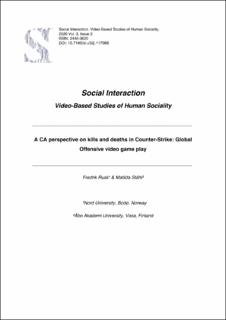| dc.contributor.author | Rusk, Fredrik | |
| dc.contributor.author | Ståhl, Matilda | |
| dc.date.accessioned | 2021-02-22T12:57:32Z | |
| dc.date.available | 2021-02-22T12:57:32Z | |
| dc.date.created | 2020-10-20T12:26:16Z | |
| dc.date.issued | 2020 | |
| dc.identifier.citation | Rusk, F. & Ståhl, M. (2020). A CA perspective on kills and deaths in Counter-Strike: Global Offensive video game play. Social Interaction - Video-Based Studies of Human Sociality, 3(2). doi: | en_US |
| dc.identifier.issn | 2446-3620 | |
| dc.identifier.uri | https://hdl.handle.net/11250/2729533 | |
| dc.description.abstract | The interest in studying multiplayer video game play has been growing since the mid-2000s. This is in part due to growing interest in games that are part of eSports settings such as Counter-Strike: Global Offensive (CS:GO), which is one of the main games within eSports, and is the video game that is studied in this paper. Studies of multiplayer video game play from a conversation analysis (CA) participant perspective appear to be scarce, although they are steadily becoming a legitimate topic in ethnomethodological conversation analytical (EMCA) studies. EMCA studies have mostly focused on aspects around the screen, and on how physically present players interact and draw upon resources both on- and off-screen. Some studies have taken the CA perspective further and blur the on-/off-screen dichotomy to better understand on-screen actions as social actions worthy of study. The aim of this article is to describe and gain new understanding of how participants socially organize their game play with a focus on sequentiality and accountability connected to “kills” (K) and “deaths” (D) in CS:GO. The social organizational structure of game play connected to K- and D-events in CS:GO can be described as a set of “rules” that participants orient to. In short, these rules appear to encompass communication efficiency: K-events are more often other-topicalized, and D-events are more often self-topicalized; spectating provides more sequential and temporal space for topicalization; and D-events are oriented to as more problematic events in need of further negotiation. In-and-through describing the social organization connected to K- and D-events from a participant’s perspective, it becomes evident that “killing” and “dying” in-game is not oriented to in a literal fashion. They are oriented to as frequent events that are basic parts of the game’s mechanics and of playing the game to win or lose. | en_US |
| dc.language.iso | eng | en_US |
| dc.publisher | Department of Nordic Studies and Linguistics University of Copenhagen. Hosted by the Royal Danish Library | en_US |
| dc.rights | Attribution-NonCommercial-NoDerivatives 4.0 Internasjonal | * |
| dc.rights.uri | http://creativecommons.org/licenses/by-nc-nd/4.0/deed.no | * |
| dc.title | A CA perspective on kills and deaths in Counter-Strike : Global Offensive video game play | en_US |
| dc.type | Peer reviewed | en_US |
| dc.type | Journal article | en_US |
| dc.description.version | publishedVersion | en_US |
| dc.rights.holder | © 2020 The Author(s) | en_US |
| dc.subject.nsi | VDP::Samfunnsvitenskap: 200 | en_US |
| dc.source.pagenumber | 28 | en_US |
| dc.source.volume | 3 | en_US |
| dc.source.journal | Social Interaction - Video-Based Studies of Human Sociality | en_US |
| dc.source.issue | 2 | en_US |
| dc.identifier.doi | 10.7146/si.v3i2.117066 | |
| dc.identifier.cristin | 1840847 | |

